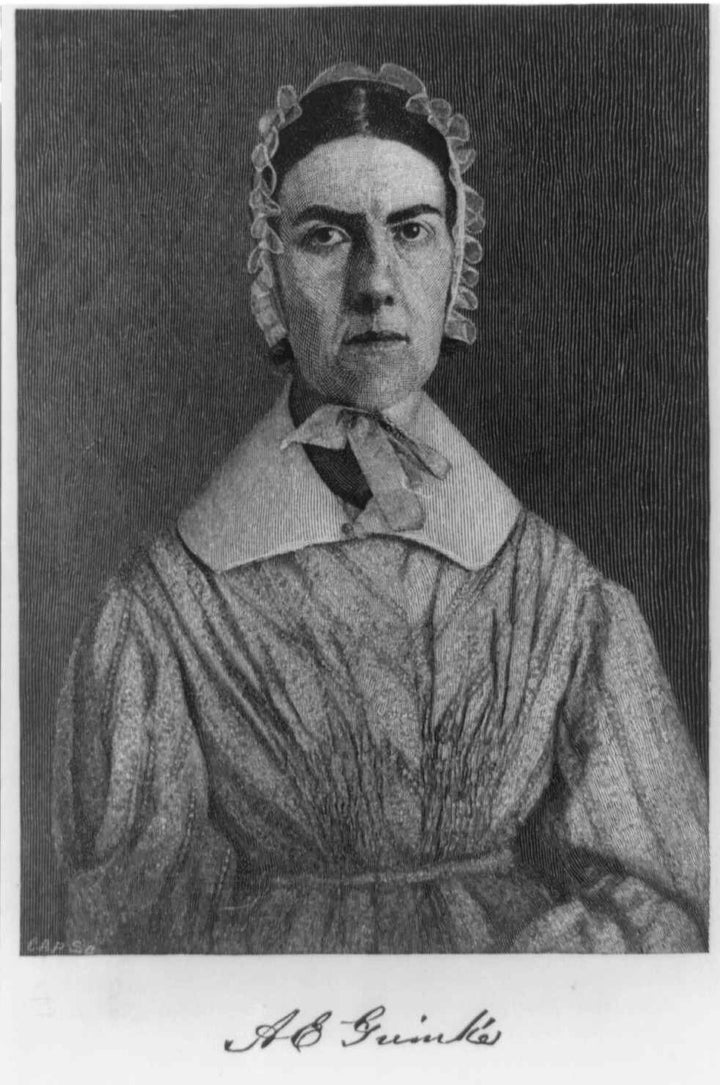
See 'The Abolitionists' starting Jan. 8 on PBS featuring the intertwined stories of Frederick Douglass, William Lloyd Garrison, Angelina Grimké, Harriet Beecher Stowe and John Brown.
In the early decades of the 19th century, a religious revival spread across the United States. For some, the promise that anyone could attain salvation through a commitment to Christ led to an optimism that society, like an individual, could be brought to perfection. For others, the evangelical message led to an apocalyptic vision that the Second Coming was near and America's sinful nature would be judged. And, for others, like the young Angelina Grimké, the message of this "second great awakening" was a mixture of hope and urgency, the belief that America must purify itself in preparation for the impending judgment day.
The youngest of 14 children, Angelina Grimké was born in 1805 into one of the wealthiest slave holding families of South Carolina. She was destined to a life of ease and material pleasures as the wife of a local planter. But her conviction that God demanded a choice of sin or salvation prompted her to reject the path prescribed for her by Charleston society. She wished, she announced, to serve in Christ's army when the final battle between good and evil began. In the journal she started keeping in 1828, she recorded her struggle to free herself of sin. She vowed give up frivolity, fashion, idleness and all luxuries. But this was not enough, for she saw these same sins and vices in her family -- and in the larger South Carolina society around her.
With the zeal of a convert, she set about to turn these sinners into saints. In 1828 and 1829 she waged a relentless campaign to reform her mother and her siblings, her friends and her neighbors, pointing out their moral failings at every turn. Her efforts met with little success. Her unbending certitude and relentless badgering drove her brothers to hide in their rooms, her friends to desert her and her mother to muster a patience that could only be termed heroic.
As a young crusader, Angelina understood that slavery was the root cause of the sins she saw around her. But this realization did not lead to any particular sympathy or concern for the enslaved men and women that were its victims. Instead, Angelina's condemnation of the slave system was based on her fear that it endangered the souls of white masters and mistresses. In other words, she worried that slave owners would face eternal damnation but ignored the plight of those suffering the system's earthly consequences.
If Angelina's thinking had continued in this same vein, there would be little reason for us to remember her. But the woman of the journal years underwent profound changes over the next decade of her life. As the 1830s began, she abandoned South Carolina for Philadelphia and here, her moral compass began to point in a new direction. She came to see slavery as a sin because of its injustice to the enslaved. She joined the abolitionist movement and by 1835 she was acknowledged as one of its most charismatic and effective speakers. She did not badger her audiences, nor attempt to shame them as she had attempted to shame her family. Instead she worked to inform and to persuade them. To that end, she transformed her own experiences as a member of the slave-owning class into a powerful rhetorical tool: "I have seen it," she declared, "I have seen it" -- and this first-hand knowledge, rare among the abolitionists, gave her appeal to end slavery a legitimacy that was unmatched.
Grimké's conviction that abolition was, as she put it, a "cause worth dying for" had led her into the anti-slavery movement. But it was her broader moral vision that led her to develop views too radical for most of her fellow abolitionists. As her popularity -- and notoriety -- grew, she found herself condemned by northern ministers, newspaper editors and many within the ranks of the movement itself for stepping outside the gender boundaries of the day. She was urged to confine herself to female audiences and private venues rather than daring to speak to what 19th century Americans called "promiscuous" audiences of men as well as women. And she was pressed to omit her frank discussion of the sexual abuse of slave women. But Angelina stood her ground. Women had a right, indeed a duty, she said, to speak out to everyone against social evils. Together with her sister, Sarah, Angelina became a spokeswoman for women's rights, especially their right to an active role in reform.
If her challenge to accepted gender roles disturbed her colleagues in the movement, it was her insistence that racial equality ought to be their ultimate goal that prompted a concerted effort to silence her. The abolition of slavery, she argued, was only the first necessary step; social, economic and political equality was due to those they were helping to liberate. Her challenge to the slave system had expanded to a challenge to the many established customs and laws restricting women and African Americans. Her urgency was no longer fueled by fears of a heavenly intervention and reckoning, but by an awareness of the continuing suffering inflicted by human society on its own members.
Worn down by criticism, Angelina married her mentor, Theodore Weld, and disappeared from the public stage in 1836. Yet her commitment to racial and gender equality never faltered. What had begun as evangelical passion had evolved into an abiding humanism in Angelina Grimké.